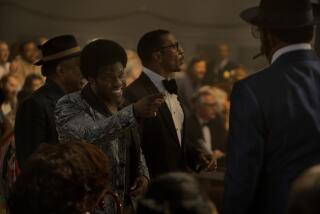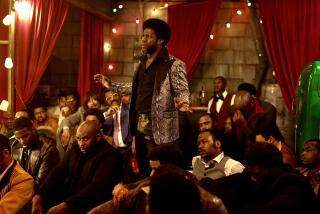From the archives:: Muhammad Ali: A fix or a fist?
Twenty-five years ago today, 4,200 people in a Lewiston, Me., high school hockey rink saw either boxing’s most shameful charade or, depending on where they were sitting, a tired, old heavyweight knocked out by a perfectly legitimate punch.
The Shame in Maine, some still call it. Others call it much ado about nothing.
It was Clay-Liston II, a rematch of the controversial Cassius Clay-Sonny Liston fight 15 months earlier at the Miami Beach Convention Center.
In Florida, the sports world had been shocked by the sight of the seemingly indomitable Liston, a 7-1 favorite, quitting on his stool after the sixth round, claiming an injured shoulder. Thus the heavyweight championship passed into the hands of Cassius Clay, who the following day announced that he had joined the Muslim faith and had a new name, Muhammad Ali.
But while shock and disbelief greeted the Clay-Liston I result, the outcome of their second bout was greeted with outrage and fury.
Fans in the Central Maine Youth Center surged toward the ring, demanding refunds and screaming, “Fix!” and “Fake!” The next day, grandstanding politicians across the United States were summoning TV cameras and proposing that boxing be banned.
For a few days, it seemed like an even bet as to whether professional boxing would make it through 1965. The May 26 headline in The Times read:
“IT ONLY TAKES MINUTE TO KILL BOXING.”
In the eye of the firestorm was a harmless-looking, countering right-hand punch that Ali, 23, a 13-10 underdog, employed to knock out Liston, believed to be at least 33, in the first round. To most, it looked more like a slap.
“I’ve spanked my kids harder,” was an oft-said line.
A quarter-century later, opinions held by those who were there, even two columnists from this newspaper, differ sharply.
Says Jim Murray: “I saw the punch, and it was a good one. But the point is, Sonny was old and out of shape — I don’t think he could’ve beaten a 10 count if he’d tripped over his shoelaces.”
Says Melvin Durslag, who then wrote for the Los Angeles Herald Examiner: “I’ve covered a lot of championship fights, and that one was the only one I didn’t think was sanitary. In my opinion, Liston either took money to go down, or the Muslims had him scared to death.”
The fight had tighter security than a Presidential visit. Everyone entering the hockey rink that night was searched. Durslag recalls that security men took away his wife’s steel knitting needles.
In the days before the fight, there was a rumor that Muslim followers of Malcolm X, who had been assassinated, were bent on revenge and planned an assassination attempt on Ali.
The fight’s closed-circuit TV promoter, Sportsvision, in effect laid odds of 1,000 to 1 on Ali — to live through the fight. The firm took out a three-day, $1-million life insurance policy on him for $1,000. Sportsvision beamed the fight to 258 closed-circuit locations.
Howard Bingham, then a training camp aide to Ali, recently recalled bizarre daybreak roadwork sessions, accompanied by slow-moving policemen.
“We’d run at sunup, the two of us, and the cops would start out running with us but couldn’t keep up,” Bingham said. “One of them would hand me a gun, then they’d wave us on.”
Reporters who interviewed Ali at his Lewiston Holiday Inn campsite had to first pass patdowns by uniformed policemen and Ali’s own security people. At the weigh-in, police guarded every door and surrounded the fighters.
Ali’s trainer, Angelo Dundee, still reacts angrily to those who suggest it was a rigged fight. “He got him with a solid punch,” Dundee said recently. “Look at the film. Sonny’s left foot jumps off the canvas just as Ali hits him. It was a flash right hand. Ali hurt a lot of guys with it.
“And he was not backing up when he hit him, like so many guys wrote. He was sliding laterally. One thing about boxing, it’s the shots you never see that hurt you the most.
“The people who say that fight was fixed should have seen Sonny’s eyes like I did, right after. A few seconds after it’s over, I felt kind of sorry for the guy and I walked up to him and said: ‘Tough, Sonny.’ His eyes looked right through me. He didn’t see nothin’.”
Both Murray and HBO boxing commentator Larry Merchant, then a sportswriter with the Philadelphia Daily News, recall hearing reports in Lewiston before the fight that things weren’t right in Liston’s camp.
“We were hearing that Sonny’s sparring partners were being paid extra to hold back,” Merchant said. “My own view is that Sonny was simply an old heavyweight, waiting to get knocked out. I believe it was a solid punch. It was such a shock at that time to see Sonny Liston on the canvas. No one had ever seen that before.”
To Mark Kram, who covered the fight for Sports Illustrated, the aftermath was a case of members of the media rushing to judgment over a punch most of them didn’t see.
“It was a perfectly valid, stunning right-hand punch to the side of the head, and (Ali) won without benefit of a fix,” wrote Kram, in his first paragraph.
“Many people,” Kram reported, “failed to see the short, fast right to the jaw that nailed Liston, and among them were numerous reporters. . . . (There is) no shred of evidence or plausibility to support the suggestion that this was anything but an honest fight.
“The knockout punch itself was thrown with the amazing speed that makes Clay different from any other heavyweight. He leaned away from one of Liston’s pawing, ponderous jabs, planted himself solidly and whipped his right arm over Liston’s left arm and into the side of Liston’s jaw.”
Kram also reported that Amos Lincoln, a sparring partner of Liston’s, had been “carefully coached” to be “well battered” at Liston’s Poland Spring Hotel camp in the days before the fight. For several weeks before that, he had routinely connected with Liston’s head with right crosses, according to Kram.
Wrote the New York Times’ Arthur Daley of the knockout punch: “The punch looked good, but not great. Certainly, it didn’t appear thunderous enough to fell the oak-thewed Sonny.”
Daley also commented on a report in a Boston newspaper afterward that Lincoln had been paid an extra $100 to let Liston batter him in final sparring sessions. “He gave Lincoln a pretty good thumping, but his camp followers were not misled,” Daley wrote. “They knew in their hearts the old man didn’t have it any more.”
Jack Hand, who covered the fight for the Associated Press, didn’t think much of the punch. “I saw it and I thought it was a glancing blow,” Hand said recently. “I was surprised Liston went down and even more surprised he didn’t get up. I remember hearing Terry Downes, the British middleweight, saying that night: ‘I’ve hit my daughter harder.’ ”
Murray Rose compiled the round-by-round summary for the AP that night and was as mystified as Hand. “It looked like a phantom punch to me,” he said. “I saw him swinging, but I just didn’t see it connect. I remember some writers saying they’d seen a solid punch, though.”
After Lewiston, Liston won 14 consecutive fights, 13 by knockout. Some pointed to that streak as evidence that Liston had done business with someone in Lewiston.
“None of the fighters he met after Lewiston were ranked fighters, until he met Leotis Martin, who knocked him out (in 1969),” Merchant said.
Liston fought once more after the Martin bout, winning a tough, bloody fight with Chuck Wepner in June 1970.
Ali went on to have one of boxing’s great careers. Yet to come were his memorable bouts with Joe Frazier and Ken Norton, his upset of George Foreman in Zaire, and his dramatic regaining of the championship, at 36, from Leon Spinks.
Ali-Liston II probably still leads the league in rumors.
“We heard all kinds of things in Lewiston,” Durslag recalled. “One theory was that the Muslims were very anxious to keep the title, that they’d told Sonny: ‘Be a good boy and take the money.’ Then we heard that Sonny was scared to death that he’d be hit by stray gunfire (meant for Ali) during the fight.
“I can remember Ali immediately afterward, as mystified as anyone, being vague about the punch. Then, after he’d showered, his line was it was an ‘anchor punch,’ taught to him by Stepin Fetchit, who was in his camp then.”
One ringside observer, former heavyweight champion Jim Braddock, said the suspect Ali right hand merely finished up what an earlier punch had begun.
“I have a feeling that this guy (Ali) is a lot better than any of us gave him credit for,” Braddock told Daley.
“It isn’t the knockout punch that sticks in my mind as much as a punch he let go (earlier). . . . It was a right to Liston’s jaw and it shook him to his shoetops. For all we know, it could have been the one that set up the knockout.”
Another former champion, the late Rocky Marciano, changed his view about the knockout punch after seeing videotape the next day.
“I didn’t think it was a powerful punch when I saw the fight from ringside,” Marciano said. “Now (after seeing video) I think Clay, seeing the opening, snapped the punch the last six inches.”
If there are dark secrets still untold from Lewiston, they won’t be told by Sonny Liston. He died on Dec. 30, 1970, under somewhat mysterious circumstances in Las Vegas. His wife, who had been gone several days, found his body on their bed.
The police report indicated that small amounts of marijuana and heroin were found near the body, but those who knew Liston maintain to this day that he never used illegal drugs.
In his final years as a fighter, Liston’s manager was Johnny Tocco, who at 79 runs a Las Vegas gym. Recently, Tocco recalled a conversation he had with Liston shortly before he died.
“I never asked Sonny about things I didn’t think he wanted to talk about,” Tocco said. “But I’d heard from someone who was once in his camp that Sonny had been told before the second Ali fight that if Ali didn’t win, Sonny’s son would be kidnapped.
“I asked him about it, and all Sonny told me was: ‘Let’s not talk about that — it was the way the fight had to go.’ ”
Ali, 48, lives on his 88-acre farm at Berrien Springs, Mich. He is afflicted with a form of Parkinson’s Disease.
The Central Maine Youth Center in downtown Lewiston stands, and its owners are contemplating adding a second rink to accommodate the children of the hockey-crazed region. The building is also used for weekend swap meets.
In the immediate aftermath of Lewiston, Ring magazine columnist Dan Daniel seems today to have been closer to the truth than most when he wrote after the fight: “Did Liston go into the tank at Lewiston? Who knows? What happened in Maine was in the nature of a fever. As Lincoln said, while Gettysburg was raging, ‘This, too, will pass.’ ”
Note: This article was originally published on May 25, 1990.
More to Read
Go beyond the scoreboard
Get the latest on L.A.'s teams in the daily Sports Report newsletter.
You may occasionally receive promotional content from the Los Angeles Times.










